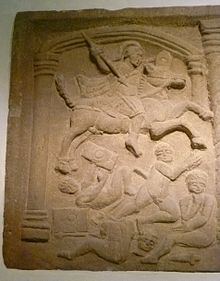Country Scotland Post town Bo'ness Fire Scottish Council area Falkirk | Sovereign state United Kingdom Police Scottish Ambulance Scottish Lieutenancy area Falkirk | |
 | ||
Mark of rome the story of the bridgeness slab
The Bridgeness Slab was found in Bo'ness, Scotland in 1869 on a promontory close to Harbour Road. The slab is a Roman Distance slab, marking a portion of the Antonine Wall built by the Second Legion, (Legio II Augusta) and was created around 142 CE. It was uncovered during excavations in 1869 on land owned by Henry Mowbray Cadell. Cadell offered it to The Society of Antiquaries of Scotland for display in the National Museum of Scotland in Edinburgh if they would provide a copy for display locally. In addition to the Latin inscription the original has sculpted panels. On the left is a victorious Roman cavalryman with four naked Britons, one being trampled, one running with a spear in his back, one sitting in apparent despair and one of whom is bound and beheaded. It has been suggested that the last act was a show of contempt for Gallo-Briton head veneration. On the right panel is a depiction of the ritual cleansing of the legion, with a soldier at the rear carrying the vexillum, or cavalry flag, of Legio II Augusta. The inscription records the building of 4,655 paces of the Antonine Wall.
Contents
The inscription in the centre panel reads "Imp CaesTito Aelio Hadriano Antonino Aug Pio p p legII Aug per m p III DCLXVI s", which when expanded reads as "Imp(eratori) Caes(ari) Tito Aelio/ Hadriano Antonino/ Aug(usto) Pio p(atri) p(atriae) leg(io) II Aug(usta)/ per m(ilia) p(assuum) III(milia)DCLXVI s(emis)". In English this translates as "For the Emperor Caesar Titus Aelius Hadrianus Antoninus Augustus Pius, Father of his Country, the Second Augustan Legion completed [the Wall] over a distance of 4655 paces".
A replica was unveiled by Bo'ness Community Council and Falkirk Council on 7 September 2012 at 56°0′58.45″N, 3°35′1.31″W in Kinningars Park, Bridgeness, Bo'ness. The original is kept at the National Museum of Scotland.
